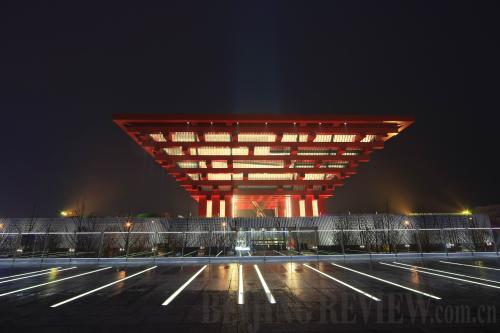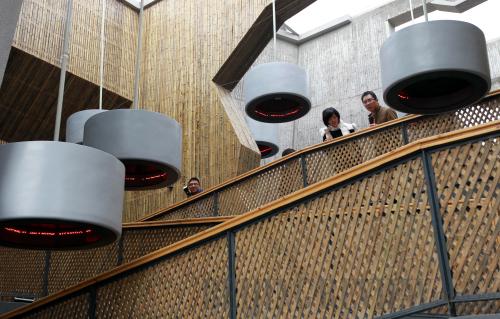|
 |
|
THE CROWN OF THE EAST: The main structure of the China Pavilion (YU XIANGJUN) |
Visitors flocked to the World Expo site in Shanghai when the grand fair officially opened to the public on May 1. The most visited pavilions on that day were the theme pavilions, the China Pavilion and China's joint provincial pavilions, said Hong Hao, Director of the Bureau of Shanghai World Expo Coordination at a press conference on the Expo's first day of operation.
Reserved tickets for the China Pavilion, or the national pavilion, were issued to regulate the flow of visitors. At some entrances, these reserved tickets were gone within minutes of being made available. Of the approximately 200,000 people touring the World Expo site on May 1, 30,000 visited the main structure of the China Pavilion and more than 70,000 visited China's joint provincial pavilions, said Hong.
China Pavilion
The main structure of the China Pavilion is designed to serve as an embodiment of Chinese culture. It employs traditional dougong brackets typical of traditional Chinese architecture. Dougong is an amazing set of interlocking brackets joining the pillars and the roof. By transferring the weight of the roof on horizontal beams to the pillars, these small brackets are pivotal in holding the large framework together. The structure is painted in red, a lucky color of Chinese people. Seven shades of red have been chosen from hundreds of red pigments. Different shades of red give the architecture a dynamic look under both natural sunlight and electric light.
The China Pavilion displays the Chinese people's wisdom in urban development. A highlight of the exhibition is the electric version of a renowned Chinese painting—Along the River During the Qingming Festival. The original scroll was painted more than 1,000 years ago and is regarded as a national treasure. It depicts a panoramic view of the prosperous city of Bianjing, now known as Kaifeng, in central China's Henan Province. Modern multimedia technology enables the people and animals in the electric version to move.
Visitors can also traverse the past and present of Chinese cities on a cable car. The car will take them to see examples of both ancient and modern Chinese architecture. For example, the area on bridge building technology extends as far back as the Zhaozhou Bridge, the world's oldest open-spandrel stone segmental arch bridge, which was built approximately 1,400 years ago and still stands in north China's Hebei Province.
In an exhibition zone on low-carbon initiatives, visitors are asked to choose from alternative ways to travel around the display area, namely, to walk, drive cars or take public transportation. A giant screen will display visitors' choices. The game is designed to raise people's awareness of low-carbon lifestyles.
Many treasures are showcased at China's provincial pavilions. In the Guangdong Pavilion, a painting on porcelain has attracted a large number of crowds. The fascinating porcelain painting is 3 meters long, 2.8 meters high, and only 5 mm thick, and features many traditional elements from Guangdong culture such as dragon boats, scenes from Guangdong opera and lions. The Guangxi Pavilion houses China's largest natural saltwater pearl. The fossil of Sinosauropteryx, the first hard proof of an evolutionary link between dinosaurs and birds for more than a century, can be seen in the Liaoning Pavilion. A giant Chinese cabbage carved out of jade is on display in the Jiangsu Pavilion, while a gigantic marble stone sculpture of Mazu, a maternal goddess worshipped in the provinces of southeast China, is showcased in the Fujian Pavilion. The typical home of a Lhasa resident is one of the highlights of the Tibet Pavilion. The Tibetan-style residence is fitted with various kinds of furniture and household electric appliances.
Best practices
The Urban Best Practices Area (UBPA) is a concept created by the organizers of the Shanghai World Expo. The area is reserved for exemplary places that have done an excellent job in improving their residents' quality of living. More than 50 cities have been selected to share their best practices, and amongst them are more than 20 Chinese cities, including Shanghai, Ningbo of Zhejiang Province, Xi'an of Shaanxi Province, Suzhou of Jiangsu Province and Beijing.
Shanghai has been selected for the UBPA with its "Eco-house in Shanghai." Its prototype is an environmentally friendly demonstration office building in Shanghai's Minhang District. The building is said to consume zero energy—the first of its kind in China. The "Eco-house in Shanghai" is built with bricks recycled from demolished old buildings, and powered by solar energy.
Tengtou Village is the only UBPA case featuring best practices from a rural area. Located in Ningbo, the pavilion displays local people's harmonious coexistence with nature. For example, the exhibition demonstrates how local people develop ecotourism and re-invest revenues from tourism to protect nature. In the pavilion, visitors also have the opportunity to listen to the sounds of nature at the Twenty-Four Terms of the year as marked in China's lunar calendar.
The UBPA case from Xi'an is the only case of heritage protection at the World Expo. The case features a real size replica of Daming Palace in Xi'an. The replica is constructed using new materials and advanced technologies. The Daming Palace was the political, economical and cultural center of China during the Tang Dynasty (618-907). Archeologists started excavation of the site in the 1950s. While preserving this heritage site, the local government has also improved the ecological environment of the surrounding area as well as the living standards of residents.
Live performances
 |
|
VOICES OF NATURE: Through 12 different objects in the shape of lamp shades, visitors to the Tengtou Pavilion in the Urban Best Practices Area can listen to the sounds of nature at different times of the year (REN LONG) |
During the World Expo, more than 20,000 live shows will be staged at the Expo site, or approximately 100 shows per day. Half of the shows will feature Chinese artists.
The Baosteel Stage in the Pudong site is a main performance venue, and can accommodate 3,500 spectators at any one time. The stage has been converted from a former steel plant. Artists from China's mainland provinces commenced performances on the stage on May 4. The performances feature folk arts and traditional skills, such as Chinese operas, paper-cutting and clay sculpture, brocade weaving and ceramics making.
Chinese martial arts will also be demonstrated during the Shanghai Expo, the first time in the 159 years of history of the World Expo. Wudang and Shaolin are the two most famous schools of martial arts.
Shanghai Puppet Troupe has created a shadow play rendition of the Romance of Three Kingdoms and a puppet play rendition of the Journey to the West for the World Expo. The troupe has revolutionized traditional shadow play and puppet play with innovative ideas and cutting-edge technology.
Chinese artists also stage joint performances with foreign artists. The Japan Pavilion has a wooden theater that can accommodate 500 people. Chinese and Japanese artists will stage approximately 35 shows each day, including a musical play on saving the crested ibis, an endangered bird.
Shanghai Dramatic Arts Center and its Finland partner have co-produced Spin, a musical thriller comedy. It is about a journalist's disclosure of a conspiracy behind the deaths of music stars, and his crusade to save a pop star, as well as his own honor and reputation.
Foreign connections
Staff members at the Norway Pavilion are dressed in red and gray uniforms inspired by the shape of one of the nation's mountains. Johan Rye-Holmboe, the designer of the uniform, said that red was chosen to pay homage to the host country because it was a lucky and positive color in Chinese tradition. Additionally, red is also conspicuous and would make it easier for visitors to identify staff to obtain their assistance.
The designer of the Spain Pavilion expressed her understanding of Chinese culture by means of wicker-woven Chinese characters. With a steel frame and a wicker exterior, the Spain Pavilion looks like a giant wicker basket. A total of 8,524 wicker panels of different textures and colors have been used, and they are arranged into the pattern of Chinese characters for the moon, the sun and friendship.
The wicker panels were handmade in Shandong Province, the homeland of Confucius, said a Spanish representative for the World Expo. She disclosed the secret about how the wicker has acquired different colors, "after boiled in water for five hours, the wicker will turn brown, and after nine hours, it will become almost black."
Carlos Blasco Villa, Spain's Ambassador to China, said that Spain and China shared the tradition of wicker weaving; a wicker pavilion would bring visitors closer to nature, and would serve as a bridge connecting the two countries.
The friendship between China and Japan is displayed at the Japan Pavilion. The exhibition commemorates a Chinese envoy's visit to Japan in the Tang Dynasty, and how expertise was transmitted into Japan.
Paper-cutting bridges the cultures of China and Poland at the World Expo. The Poland Pavilion looks like a folded paper box carved into the patterns of paper cut-outs. Rafal Baniak, Undersecretary of State in Poland's Ministry of Economy, said that he hoped Chinese visitors would feel at home at the Poland Pavilion on May 1 at the ceremony to open the pavilion. | 